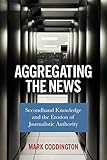Aggregating the News : Secondhand Knowledge and the Erosion of Journalistic Authority / Mark Coddington.
Material type: TextPublisher: New York, NY : Columbia University Press, [2019]Copyright date: ©2019Description: 1 online resourceContent type:
TextPublisher: New York, NY : Columbia University Press, [2019]Copyright date: ©2019Description: 1 online resourceContent type: - 9780231187305
- 9780231547192
- 070.4 23
- PN4784.O62
- PN4784.O62
- online - DeGruyter
- Issued also in print.
| Item type | Current library | Call number | URL | Status | Notes | Barcode | |
|---|---|---|---|---|---|---|---|
 eBook
eBook
|
Biblioteca "Angelicum" Pont. Univ. S.Tommaso d'Aquino Nuvola online | online - DeGruyter (Browse shelf(Opens below)) | Online access | Not for loan (Accesso limitato) | Accesso per gli utenti autorizzati / Access for authorized users | (dgr)9780231547192 |
Frontmatter -- Contents -- Acknowledgments -- Introduction: Understanding Aggregation in Context -- Chapter One. Gathering Evidence Of Evidence Aggregation As Second-Order Newswork -- Chapter Two. Making News By Managing Uncertainty -- Chapter Three. Inferiority And Identity: Aggregators And The Journalistic Profession -- Chapter Four. Clickbait, Analytics, And Gut Feelings: How Aggregators Understand Their Audiences -- Chapter Five. Atomization And The Breakdown (And Rebuilding) Of News Narrative -- Chapter Six. Conclusion: Aggregation, Authority, And Uncertainty -- Notes -- Selected Bibliography -- Index
restricted access online access with authorization star
http://purl.org/coar/access_right/c_16ec
Aggregated news fills our social media feeds, our smartphone apps, and our e-mail inboxes. Much of the news that we consume originated elsewhere and has been reassembled, repackaged, and republished from other sources, but how is that news made? Is it a twenty-first-century digital adaptation of the traditional values and practices of journalistic and investigative reporting, or is it something different-shoddier, less scrupulous, more dangerous?Mark Coddington gives a vivid account of the work of aggregation-how such content is produced, what its values are, and how it fits into today's changing journalistic profession. Aggregating the News presents an analysis built on observation and interviews of news aggregators in a variety of settings, exploring how aggregators weigh sources, reshape news narratives, and manage life on the fringes of journalism. Coddington finds that aggregation is defined by its derivative relationship to reporting, which colors it with a sense of inferiority. Aggregators strive to be seen as legitimate journalists, but they are constrained by commercial pressures, professional disapproval, and limited access to important forms of evidence. The first comprehensive treatment of news aggregation as a practice, Aggregating the News deepens our understanding of how news and knowledge are produced and consumed in the digital age. By centering aggregation, Coddington sheds new light on how journalistic authority and legitimacy are created-and the consequences when their foundations are eroded.
Issued also in print.
Mode of access: Internet via World Wide Web.
In English.
Description based on online resource; title from PDF title page (publisher's Web site, viewed 02. Mrz 2022)


